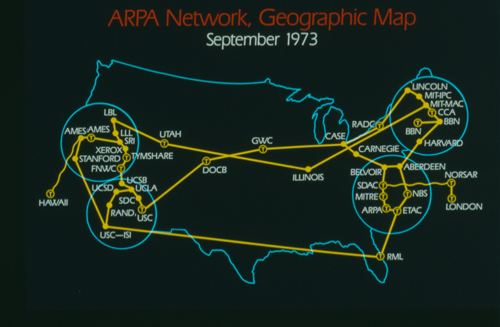The invention of the internet
Did you know? Today, almost one-third of the world’s 6.8 billion people use the internet regularly?
The internet got its start in the United States more than 50 years ago as a government weapon in the Cold War. For years, scientists and researchers used it to communicate and share data with one another. Today, we use the internet for almost everything, and for many people it would be impossible to imagine life without it.
After Sputnik’s launch,people began to think more seriously about science and technology. Schools added courses on subjects like chemistry, physics and calculus. Corporations took government grants and invested them in scientific research and development. And the federal government itself formed new agencies, such as the National Aeronautics and Space Administration (NASA) and the Department of Defense’s Advanced Research Projects Agency (ARPA), to develop space-age technologies such as rockets, weapons and computers.
Due to a concern about what might happen in case of a Soviet attack back in days , scientist from M.I.T. and ARPA named J.C.R. Licklider proposed a solution to this problem: a “galactic network” of computers that could talk to one another. In 1965, another M.I.T. scientist developed a way of sending information from one computer to another that he called “packet switching.”
Packet switching breaks data down into blocks, or packets, before sending it to its destination. That way, each packet can take its own route from place to place.
In August 1962, Licklider and Welden Clark published one of the first descriptions of a networked future in the paper “On-Line Man-Computer Communication.
On October 29, 1969, ARPAnet delivered its first message: a “node-to-node” communication from one computer to another.
- In 1969 only 4 computers were connected to the network.
- In 1971 University of Hawaii’s ALOHAnet, and two years later it added networks at London’s University College and the Royal Radar Establishment in Norway.
The networks based on the ARPANET were government funded and therefore restricted to noncommercial uses such as research; unrelated commercial use was strictly forbidden. This initially restricted connections to military sites and universities. During the 1980s, the connections expanded to more educational institutions, and even to a growing number of companies .

By the end of the 1970s, a computer scientist named Vinton Cerf had begun to solve this problem by developing a way for all of the computers on all of the world’s mini-networks to communicate with one another. He called his invention “Transmission Control Protocol,” or TCP. (Later, he added an additional protocol, known as “Internet Protocol.” The acronym we use to refer to these today is TCP/IP.)
- 1980s, researchers and scientists used it to send files and data from one computer to another.
- 1991 a programmer in Switzerland named Tim Berners-Lee introduced the World Wide Web.
- 1992 a group of students and researchers at the University of Illinois developed a sophisticated browser that they called «Mosaic». (It later became «Netscape».) Mosaic offered a user-friendly way to search the Web: It allowed users to see words and pictures on the same page for the first time and to navigate using scrollbars and clickable links.
As a result, companies of all kinds hurried to set up websites of their own, and e-commerce entrepreneurs began to use the internet to sell goods directly to customers.
Early computers had a central processing unit and remote terminals. As the technology evolved, new systems were devised to allow communication over longer distances (for terminals) or with higher speed (for interconnection of local devices) that were necessary for the mainframe computer model.
Article sources :History of the Internet and Wikipedia
Read more articles about technology and internet on our Blog

